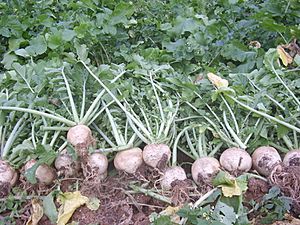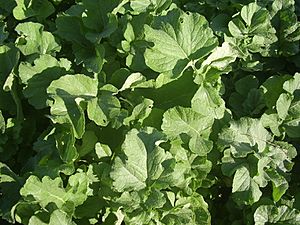Gegeol radish facts for kids
Quick facts for kids GegeolmuGegeol radish |
|
|---|---|
 |
|
| Genus | Raphanus |
| Species | R. raphanistrum |
| Subspecies | R. raphanistrum subsp. sativus |
| Cultivar group | White radish |
| Cultivar | Gegeolmu / Gegeol radish |
| Origin | Korea |
| Korean name | |
| Hangul |
게걸무
|
|---|---|
| Revised Romanization | gegeolmu |
| McCune–Reischauer | kegŏlmu |
| IPA | [ke.ɡʌl.mu] |
Gegeolmu, also known as gegeol radish, is a special kind of white radish. It's round and has a strong, spicy flavor. This radish has a thick skin and firm inside. What's really cool is that it stays firm for a long time, even after being stored for years as kimchi.
This unique radish is a special crop from Icheon and Yeoju in Korea. It's so important that it's listed in the Ark of Taste. This is an international list of foods that are in danger of disappearing.
Contents
What is Gegeol Radish?
The gegeol radish is smaller and firmer than most other Korean radishes. A whole plant, including its root and green leaves, usually weighs about 500 grams (18 oz). The root itself is shaped like a cone or a turnip. It measures about 6–7 centimetres (2.4–2.8 in) across and 20 centimetres (7.9 in) around. Its green leaves tend to spread out wide instead of growing straight up.
Compared to regular Korean radishes, gegeol radishes have less water. But they have more good stuff like protein, fiber, and important minerals. These minerals include magnesium, potassium, and calcium. Gegeol radishes also have a higher amount of a sulfur compound. This compound is what gives them their extra sharp and spicy taste.
How Gegeol Radish is Grown
For a long time, gegeol radishes were grown by families for their own use. Farmers would plant them in cotton or soybean fields. They grew them in between the main crops in the Icheon and Yeoju areas of South Korea. Now, this radish is also grown for sale as a local specialty.
Farmers can plant either the seeds or the roots in early spring. By late spring or early summer, they can collect seeds for the next year's planting. The young leaves of the radish can be picked all through spring, summer, and autumn. These leaves are used as fresh vegetables called namul. In the autumn, the entire radish plant is ready to be harvested.
Cooking with Gegeol Radish
Gegeol radish has a strong, spicy flavor. Because of this, the roots are often salted first. Then, they are buried in the ground during winter. This helps to mellow their strong taste. The green leaves can be used fresh or dried. They are popular in namuls (seasoned vegetable dishes), soups, and many other Korean dishes.
Gegeol Radish Ingredients
- Gegeolmu-jocheong: This is a syrup made from gegeol radishes. It's like regular rice syrup (jocheong), but instead of water, they use juice from boiled gegeol radishes.
- Gegeolmu-ssi-gireum: This is oil pressed from gegeol radish seeds.
- Mucheong: These are the green leaves of the radish. They can be dried to make siraegi or used fresh in cooking.
- Mu-mallaengi: This means "dried radish." It's made by cutting radishes into thin strips and drying them in the sun.
- Siraegi: These are dried radish greens. Gegeol radish siraegi is often added to dishes like dak-bokkeum-tang (spicy chicken stew).
Popular Gegeol Radish Dishes
- Gegeolmu-dongchimi: This is a type of dongchimi, which is a clear, watery radish kimchi. Sliced and salted gegeol radishes are used. Other ingredients like apples, pears, garlic, ginger, and mustard greens are added. Everything is soaked in cooled, boiled water.
- Gegeolmu-kimchi: This is a type of kimchi made with diced gegeol radish. The radish is salted and mixed with lightly salted mustard greens. A special seasoning is added. This kimchi is quite salty and can last for more than three years.
- Gegeolmu-jangajji: This is a type of jangajji (pickled dish). Diced and salted gegeol radish is colored with gardenia seed water. Then, it's soaked in salty water and left to age.
Gegeol Radish Tea and Sweets
- Gegeolmu-cha: This is gegeol radish tea. It's made by dry-frying sliced gegeol radishes. This tea is known to be a natural antioxidant. It may also help with breathing problems or minor stomach issues.
- Gegeolmu-jeonggwa: This is a type of traditional Korean sweet called jeonggwa. Thinly sliced gegeol radishes are salted overnight and drained. Then, they are soaked in rice syrup for a short time. After that, the pieces are dried on a tray for a day. Once dried, they are often shaped into pretty flowers.
Images for kids



